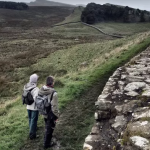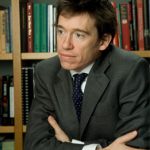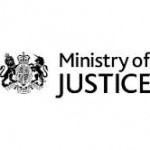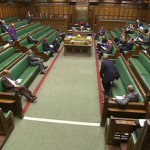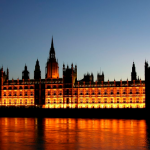Rory Stewart walks Hadrian’s Wall
Article first published in The Financial Times on 20 June 2014.
Hadrian’s Wall begins a little bewilderingly, buried under the settlements east of Newcastle, but stretches into some of the loveliest, loneliest country in Britain. Segedunum, the fort at the eastern end of the wall, has been excavated from under tight terraces of Victorian housing beside the former shipyards at Wallsend. At one end is a reconstructed bathhouse, neatly plastered in blue and white. The Roman writer Tacitus claimed the British had embraced bathing with enthusiasm. But the fashion didn’t last: this bathhouse was abandoned along with perhaps a thousand others, almost exactly as the Roman legions left, 1,600 years ago. Today, restored to working order, it still seems a little alien, advanced and luxurious.
From here, the Hadrian’s Wall Path runs along an abandoned rail track, in the shadow of half-abandoned administrative buildings, above the dockyard gates. My plan was to follow it west to Willowford, on the Cumbrian border: a walk of just over 40 miles, do-able in a weekend, although three days would be more comfortable.
I emerged, after a couple of hours, on to the Newcastle quays. A Pyrenean mountain dog, the size of a small pony, stood, newly blow-dried, in the centre of the street. It was being admired by three Persian-Bahraini women in giant sunglasses. One petted it, another jumped in terror whenever it looked up, and a third posed for photographs. I stopped for an espresso from a van parked on the quayside.
On the outskirts of Newcastle, my boots sounded heavy on the new pavement. I hurried through mini-roundabouts, stared at porcelain decorations on windowsills, and large empty armchairs in front rooms. Women in new black trouser-suits, smoking outside a hair salon, watched me pass, and I felt a little embarrassed to be seen in a city in my stained blue trousers, and with a large backpack.
Then I was beyond the suburbs, into flat farmland, where high hedges blocked the view, until gradually the hills emerged. Coming down a long slope, I saw the first clear section of the wall: a line of square sandstone blocks standing 3ft high. The section was only about 20 yards long but you could see the diagonal scratches of the Roman chisels that had built it in the 2nd century. The track followed a quiet road, alongside green fields full of large, pale, continental cattle. Every 10 or 20 minutes was another short section of wall or the remains of the once 10ft deep Roman ditch, or vallum, that ran along its southern side.
Fourteen miles, or five hours’ walk from Newcastle, a small metal noticeboard indicated the site of a fort called Vindobala. Beyond the sign was rough pasture. Thick-necked, flat-faced, Texel sheep moved solidly back and forth, inspecting the grass as closely as an archaeologist but there was no Roman stone to be seen. I stopped to eat an egg sandwich.
The 500 men who had been based in this empty green field had not been limited to egg sandwiches. Bones, and documents, recorded rich meat, Italian wine, north African cereals, Spanish olive oil and fish paste. This fort had once contained Frisian soldiers from Holland. Further west at Carvoran were Syrian archers. They came from Hama, now caught up in the Syrian war, and they had left a poem carved in stone that celebrated their cities and the marriage of a Syrian woman to an emperor from Libya. Each unit would have brought their own languages, some brought their gods; all brought their cuisine. One African unit had left the remains of an African casserole dish in the ground.
As I walked on, the ground became rougher, the soil poorer: there were fewer cows and more sheep. It was becoming clear how startling this wall must once have been. It had been a rigid mortared structure dropped in the midst of a local culture that had never built in mortared stone. It was so long as to be, to the human eye at least, endless, and because it was 12ft to 15ft high, it concealed everything behind it: cutting a familiar landscape, suddenly, in two. Everything on my right would have been wet sour ground, crags and moss, and scrub-trees, and a glimpse of further ridges. But on my left there would have been no view, no natural thing, nothing except a wall, up to three times the height of a man. It would have felt like the perimeter wall of a vast compound.
Every mile, the wall seemed ever more prodigious, and incomprehensible. The rain came and went. I reached sections where the grey stone became wet black granite and then a pale dry, red sandstone. Sometimes the wall ran along the edge of great cliff escarpments, or plunged into narrow gullies, but the shape of the almost square blocks never changed. An iron-age walker would have been aware of its almost inhuman precision. Every 300 yards was another manned turret – and every Roman mile, a milecastle.
The six-mile diversion from the wall at Chollerford south to the town of Hexham adds three hours of walking; perhaps it would be better to take a taxi. I stayed at the Beaumont Hotel (good breakfast, friendly owner) facing the pink-tinged dark stone of the old Abbey. Following a parade of prams that came down the cobbled streets from Argos, I walked into the Abbey.
By the stairs stood a carved sandstone tombstone of a young Roman soldier. His face was invisible but he had settled his flag firm by his waist, as his horse reached skyward. Focused on the rearing pony between his knees, he hardly seemed to notice how his fine leather boot kicked against the naked bottom of a kneeling man, prostrated beneath the horse’s belly. The crouching nude held a naked sword. His head was stretched back, so at first it looked as though it were stretched in agony but it was at an angle far beyond any anatomical possibility: he was decapitated. He was a Briton – a naked barbarian, kicked aside by the leaping hooves of Rome.
Approaching the Roman fort at Housesteads the next day, I met a large, white-haired man, who walked with giant strides. He wore short white socks, hiking boots, a kilt that came down to the middle of his calves, and no sporran. He was followed by a woman in a kilt that was more of a miniskirt.
“We are the Club of Irish-Scottish Californian Lawyers,” he told me. “Every year, we go on a trip to celebrate our heritage. This year is Hadrian’s Wall.” What had the experience been like?
“Pretty punishing to be honest, long days, but we’ll make it.”
I ran across the hill from the fort on the ridge at Housesteads to the fort at Vindolanda, because I was bored of the slow trudge. I came through a quarry, across a road, down into a ditch, and over a fence, finding myself amid the familiar stone rectangles that seem the standard way of presenting the foundations of a Roman fort.
Last time I had visited, I found archaeologist Andrew Birley crouching beside a path, staring at a hole which he said had once contained a native hut. “We’ve been excavating here for 80 years,” he said, “and I reckon we’ve uncovered about 20 per cent of the site.” At this rate, I worried, they would be excavating for longer than the fort had been occupied. Now, however, he was nowhere to be seen and I wandered the site alone.
Birley’s grandfather had bought the fort at auction in 1929, and then dedicated his family’s life to restoring it. There had been a break for almost 15 years, when the government tried to prevent them from excavating it (and when they reconstructed one section of wall, local council officials refused it planning permission on the grounds that it was not in keeping with local architectural traditions).
People who I thought would have liked the fort, often seemed to complain that it was “overdone” and groaned when I praised it. I liked the fact that they had relied for decades on teams of volunteers – hundreds of people camping over the summer – often students of his family, most of whom had become professors. I liked the fact that they had become a northern family rooted to this soil and this project.
The Birleys’ most famous discovery was a cache of Roman correspondence in the deep peat soil. It was written on thin wooden tablets, the ink could only be revealed under the most specialist lighting conditions, and informed guesswork seemed to underlie every act of deciphering. It was a tiny fraction of what must have once existed – and it was on a rubbish pile, intended to be destroyed. But the correspondence revealed centurions, setting off south to pick up more supplies, negotiating with contractors for transport; and it restored the voices of civilian traders, enraged with the military brutality. There were endless leave tickets, and muster rolls, showing soldiers flowing back and forth, down to London, or on temporary postings to neighbouring bases, or to the governor’s staff.
The museum at Vindolanda contained Samian pottery, fine red ware, imported to this remote heathered valley from a ceramics factory in what was now central France – almost as though a contemporary officer had brought his family silver to a forward operating base in Afghanistan. There was painted glass, a marble altar, an elaborate decorated leather horse-mask, and a whole case of leather shoes, women’s sandals, children’s boots, a little worn, still carrying the shape of the lost feet of their owners.
Willowford Farm, close to the village of Gilsland, is constructed from the stones of the wall, like many old buildings in the area. On a lintel is a Roman inscription “from the Fifth cohort, the century of Gellius, Phillipus, built this”.
The neat and warm bedroom in which I stayed for my final night was built into the side of the farmhouse courtyard. Breakfast was fresh loaves of granary bread, home-made jam, and thick-cut Cumbrian bacon.
I went out at first light. The farmhouse lay on a ridge, and I stood outside. The farm’s two collies seemed willing for a moment to leave their bald tennis ball and consider the view. Mist was rising from the river below, revealing the wall. Its rough stone face ran straight through the grass field – a border, drawn with a colonial ruler, cutting a landscape in two. A footbridge led up to Birdoswald fort, whose garrison had once been tall red-headed Dacians, from a homeland almost 2,000 miles away. But I could see nothing except the wallstone, and the fellside, scattered with Swaledale sheep, in a landscape where perhaps a hundred thousand people, from places stretching from Gaul to the Black Sea, had eaten olives, and gazed at the wet ground, and the scrub, and the distant line of hills, for 300 years.




